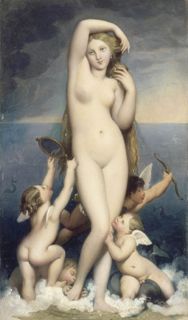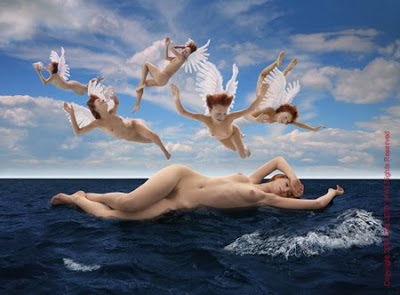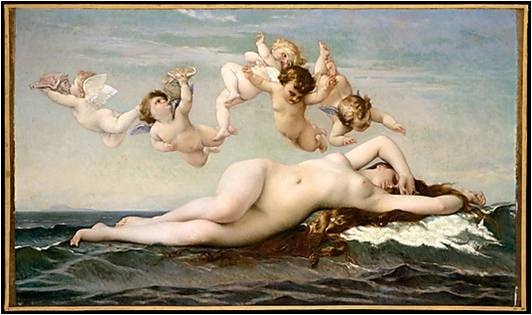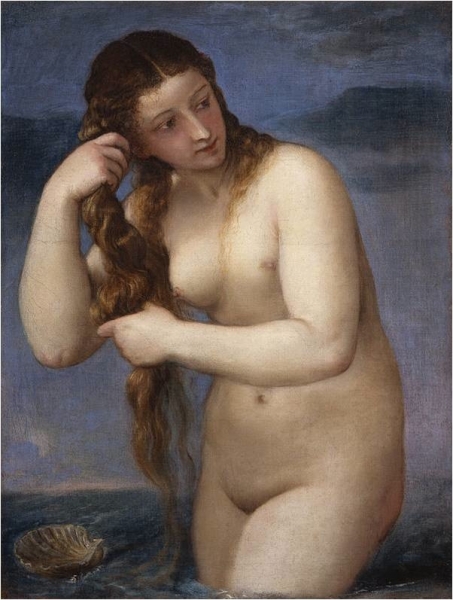What do we actually know about Aphrodite? Do we really know her? In ancient times, in addition to the earthly aspect (Πάνδημος) of Aphrodite, the patroness of the wild and passionate love between young people and of aspiring souls in love, another Aphrodite, namely the Celestial Aphrodite (Ουρανία), dominates in the sky like a black Madonna. She is one of the most enigmatic figures created by the human unconscious. Celestial Aphrodite, called Μέλαινα, (Meliae, i.e., Black, Dark), was a goddess of destruction, darkness, chaos, ruthless opposition. She did all that not because of viciousness but because she wanted to revitalize and renew the whole universe through love. Of course, we are talking about a love of cosmic dimensions in which galaxies absorb other galaxies to merge with them, to achieve unity, completeness, and the sole and absolute being. Aphrodite also had 'avatars' such as Medea, Ariadne, Scylla, Hecate and they have developed into separate deities or mythological figures over time.
 Yes, mythological figures have the ability to merge into one other, to pull toward themselves contradictory and seemingly exclusive features. Black Aphrodite (as well as "apocryphal" Black Demeter) is almost unknown, she is lost to us. We know Aphrodite as "gold-crowned" and "beautiful", "sweetly-winning", "coy-eyed", "fulgent", "all-golden", "with a sweet and charming smile"; we find it difficult to recognise her as Melainis. According to Pausanias, the ancients called her "Black" because the sexual act of humans takes place during the night. According to French philosopher and anthropologist Jean-Pierre Vernant, however, this multifaceted goddess is a product of the ancient mythological thinking and her figure expresses the perception of the world as a result from the constant mixing of opposites. He pays special attention to the retinue of the goddess of love, which includes the children of the Night, Nyx (Νυξ), Fraud (Απάτη/Εξαπάται) and Loving Tenderness (Φιλότης). In the eyes of Vernant, besides being the patroness of beauty, joy and love Aphrodite was one of the female figures of death in antiquity.
Yes, mythological figures have the ability to merge into one other, to pull toward themselves contradictory and seemingly exclusive features. Black Aphrodite (as well as "apocryphal" Black Demeter) is almost unknown, she is lost to us. We know Aphrodite as "gold-crowned" and "beautiful", "sweetly-winning", "coy-eyed", "fulgent", "all-golden", "with a sweet and charming smile"; we find it difficult to recognise her as Melainis. According to Pausanias, the ancients called her "Black" because the sexual act of humans takes place during the night. According to French philosopher and anthropologist Jean-Pierre Vernant, however, this multifaceted goddess is a product of the ancient mythological thinking and her figure expresses the perception of the world as a result from the constant mixing of opposites. He pays special attention to the retinue of the goddess of love, which includes the children of the Night, Nyx (Νυξ), Fraud (Απάτη/Εξαπάται) and Loving Tenderness (Φιλότης). In the eyes of Vernant, besides being the patroness of beauty, joy and love Aphrodite was one of the female figures of death in antiquity.
What archetypal figure can be distinguished in the figure of Aphrodite?
One of the most fundamental archetypes of human psychological reality can be discerned in the figure of Aphrodite from the perspective of analytical psychology, namely the archetype of the Great Mother Goddess. Love and death, the womanly and the nocturnal, the good and the terrifying aspect of an undifferentiated primary figure of femininity that expresses the female spirit through the language of  myth meet and intersect in this archetype. According to German psychologist Erich Neumann, Renaissance Venus is a replica of the great goddess of antiquity crippled by patriarchal thinking and reduced to a symbol of love and sexuality. Moreover, in the figure of Anadyomene we can find the primeval mythological idea of the birth and the beginning embodied in the two major stories of antiquity about the divine child and the Goddess Cora (an alias of Persephone). Aphrodite represents and expresses the inseparable mother-and-daughter dyad traditionally embodied by Demeter and Persephone, containing at the same time the aspects of the Great Mother and the young seductress. Although we are used to associating her name with different love affairs, at the time of her emergence from the sea foam, she is η Πρωτόγονη Κόρη, the Primary Virgin, the divine personification of birth, purification and renewal.
myth meet and intersect in this archetype. According to German psychologist Erich Neumann, Renaissance Venus is a replica of the great goddess of antiquity crippled by patriarchal thinking and reduced to a symbol of love and sexuality. Moreover, in the figure of Anadyomene we can find the primeval mythological idea of the birth and the beginning embodied in the two major stories of antiquity about the divine child and the Goddess Cora (an alias of Persephone). Aphrodite represents and expresses the inseparable mother-and-daughter dyad traditionally embodied by Demeter and Persephone, containing at the same time the aspects of the Great Mother and the young seductress. Although we are used to associating her name with different love affairs, at the time of her emergence from the sea foam, she is η Πρωτόγονη Κόρη, the Primary Virgin, the divine personification of birth, purification and renewal.

Why did you turn to these poets and works?
Among the many incarnations of Aphrodite in literature I preferred three Ionian-island poets, because the scientific forum was devoted to the Ionian culture, literature and history. Kythira, incidentally, is one of the Ionian Islands, but I put into "The Eternal Journey to Kythira" the idea of the eternal return to mythology as a source of the greatest truths, a return to the roots, if you will. Dionysios Solomos (1798-1857) from the island of Zakynthos, Lorentzos Mavilis (1860-1912), born on the island of Ithaca, and Angelos Sikelianos (1884-1951) from the island of Lefkada are not the only Greek poets inspired by this figure, but even the three selected short poems show how masterly the figure arranges and rearranges its meanings, undergoing transformation and being born again and again, thus bringing each time new messages. For example, "Corfu" by Lorentsos Mavilis was written as a palimpsest over  the mythological version of the double birth of Aphrodite and of the island of the Phaeacians, just like it is preserved in "Argonautica" by Apollonius of Rhodes (3rd century BC) that tells the myth of the voyage of Jason and the Argonauts to Colchis in search of the Golden Fleece. In the fourth book of the epic, the sickle (δρεπάνη) of the terrible emasculation pairs with the reaping hook of goddess Demeter. The emergence of the island and the birth of the deity intersect and intertwine in a double theogony, the symbol of the moon and fertility being their common denominator. This mythological motif of the Hellenistic text was "rewritten" by Mavilis who is the author of some of the finest sonnets in Greek poetry.
the mythological version of the double birth of Aphrodite and of the island of the Phaeacians, just like it is preserved in "Argonautica" by Apollonius of Rhodes (3rd century BC) that tells the myth of the voyage of Jason and the Argonauts to Colchis in search of the Golden Fleece. In the fourth book of the epic, the sickle (δρεπάνη) of the terrible emasculation pairs with the reaping hook of goddess Demeter. The emergence of the island and the birth of the deity intersect and intertwine in a double theogony, the symbol of the moon and fertility being their common denominator. This mythological motif of the Hellenistic text was "rewritten" by Mavilis who is the author of some of the finest sonnets in Greek poetry.